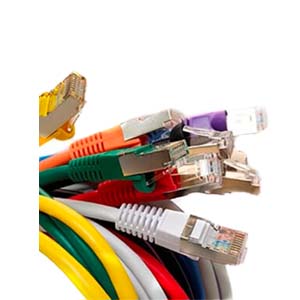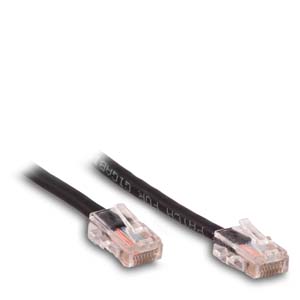Cables Blog
Best Practices for Data Center Infrastructure Design
by VIKAS DAYAL • January 21, 2020
Cables.com, Data Center, Reseller, VAR

Most businesses depend on data centers for their operations. Whether your business outsources data storage and processing or built a data center or centers from the ground up, the data management infrastructure inside the building is every bit as important as integrated building systems, such as power, cooling, and fire protection. Racking, cabling, cable management, and connectors all factor into a data center’s optimal operation. Here are some best practices for data center infrastructure design:
Plan for Growth and Change
There’s a difference between planning for growth and over-building. With ever-increasing demands for bandwidth and speed, there will be corresponding demand for improvements in cabling that can handle it. But just adding square footing as a shot in the dark could end up being costly—you could find yourself paying for power, cooling, and maintenance for empty space. Think about the future and accommodate with the following methods:
- Using modular systems that are adjustable, moveable, and easy to reconfigure. Consider height, width, depth, weight capacity, and airflow when selecting racking and cabinets.
- Use efficient, co-engineered cabling and connectors, and use cable management that accommodates required ventilation and cooling. Anticipate advancement in cable technology but plan for hybrid use—current conditions may require a combination of copper and optical cable, for example.
- Decide on ToR (top of rack), MoR (middle of row), or EoR (end of row) configurations for cabling and connectors. You may end up with a combination of these or a hybrid design,but ensure that whatever you end up with will accommodate a number of factors. These include copper and optical cable, the cabling size you select, and the cable management you need to keep everything running without interfering with other necessary design considerations.
Comply with Standards
This may seem like a no-brainer, but where your data center is located and the scope of service it provides will impact the international and national standards you should follow, as well as federal, state and local laws. Also stay up to date with building codes and regulations that govern things such as fire safety, hazardous substances and waste management, and overall sustainability. Among the most important standards to consider is ANSI/TIA-942, a great baseline for the design and building of any data center. Determine which of ANSI/TIA rating level you can reasonably achieve for your operation and plan to move up a level in the future. Consider pursuing ANSI/TIA-942 design, site and/or ready certification for the rating level you have selected.
Other standards that may come into play, depending on what business you are in and whether you operate internationally, could include standards and regulations governing:
- Uptime
- Information security and privacy
- Physical security systems
- Financial and securities laws and regulations
- Credit and payment card information security
- Continuity
- Management and operations
Organize and Document
You’ve planned for growth and change, and selected modular racking and cabinets. You’ve selected cable management that can accommodate both copper and optical fiber cabling, and anticipate future upgrades. What happens when it becomes necessary to reorganize, move, rearrange, or upgrade everything? Document and label everything as it is now, and prepare a procedure in advance, to follow in the event you need to move or replace things.
If Outsourcing, Consider Experience
If you’re entrusting your data center design and management to someone else, experience is critical. When selecting a partner, require candidate companies to demonstrate adherence to best practices for data center infrastructure design, and how they plan for and accommodate an ever-changing data center landscape. Experts estimate that ninety percent of currently active equipment will be replaced within five years. Ensure that manufacturers or organizations you might work with are ahead of the curve on new building and infrastructure technologies. This includes everything from cabling and cooling to power, pathways, and installation, and has the experience to provide solutions quickly and efficiently.
Purchasing Equipment and Supplies
If you’re building, equipping, or re-equipping a data center, you’ll need a lot of equipment. Large and small businesses may choose to work directly with equipment manufacturers, or purchase equipment online. Shop around for the best place to buy cables online, and you may also find a great supply source for racking, cable connectors, and cable management. Also consider cabling and equipment you may need if you’re deploying video or setting up a closed-circuit video or television network for use in training, internal meetings, or secured video communications.
Does your business use computer-assisted-design, visualization technology, 3D printing, virtual reality simulations, or other data-guzzling applications over a bandwidth-challenged network? Think about whether your plan contemplates the need to expand capacity to facilitate designers, architects, scientists, and engineers. Will your data center have the space, the cabling, and the capacity to handle it all?
The Internet of Everything
The world is hurtling toward the interconnection of everything. For consumers, that may mean smart appliances, smart speakers, or smart homes that self-regulate and adapt to residents’ patterns and habits. For businesses, it may mean increased decentralization, more virtual communication, smart buildings, and a new way of thinking about energy information storage and security. Adaptability is key to your data center operation’s future.
Thought leaders in the data industry estimate 175 zettabytes of data will need a home by 2025. Themes for the future include considering climate when locating data centers, new types of storage that increase capacity while lowering cost, and even the disappearance of data centers entirely in favor of “crowdsourced” networks. Companies may consider building data centers closer to energy sources and the source of the data to be stored. These are called “edge” data centers, and they can be effective for machines and devices that exist within the “internet of things” by reducing the need to transfer data up to and back down from the cloud. Other connected devices benefit from “hyper-local” data storage in facilities about the size of a shipping container.
By contrast, the world’s mega-tech companies are buying up land and building massive capacity to house and transfer data. Tech giants are developing new infrastructure to connect and secure it all, including new undersea or underground cabling, or are repurposing other existing structures to store data using clean energy sources.
Whether large or small, your data center requires infrastructure that includes cabling, connectors, and cable management that is flexible, adaptable and forward-looking.











